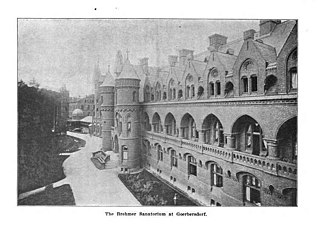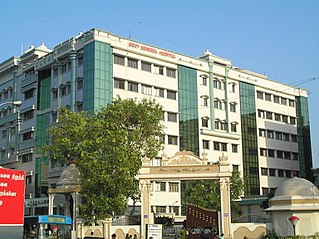
Stanley Medical College (SMC) is a public medical college located in Chennai, Tamil Nadu, India. Though the original hospital is more than 200 years old, the medical college was formally established on 2 July 1938.

A sanatorium, also sanitarium or sanitorium, are antiquated names for specialised hospitals, for the treatment of specific diseases, related ailments and convalescence. Sanatoriums are often in a healthy climate, usually in the countryside. The idea of healing was an important reason for the historical wave of establishments of sanatoriums, especially at the end of the 19th- and early 20th centuries. One sought, for instance, the healing of consumptives, especially tuberculosis or alcoholism, but also of more obscure addictions and longings of hysteria, masturbation, fatigue and emotional exhaustion. Facility operators were often charitable associations such as the Order of St. John and the newly founded social welfare insurance companies.

Tambaram is a satellite city of Chennai, located in the Chengalpattu district of Tamil Nadu, governed by the Tambaram City Municipal Corporation and part of the Chennai Metropolitan Area.

Madras Medical College (MMC) is a public medical college located in Chennai, Tamil Nadu, India. Established in 1835, it is the one of the oldest medical colleges in India, as well as in Asia.
Tambaram Sanatorium is a locality between Chromepet and Tambaram, in Chennai, India. The neighbourhood is served by Tambaram Sanatorium railway station on the Chennai Beach–Villupuram section via Tambaram of the Chennai suburban railway.

Rajiv Gandhi Government General Hospital is a major state-owned hospital situated in Chennai, India. The hospital is funded and managed by the state government of Tamil Nadu. Founded in 1664 by the British East India Company, it is the first modern hospital in India. In the 19th century, the Madras Medical College joined it. As of 2018, the hospital receives an average of 12,000 outpatients every day.

Thanjavur Medical College (TMC) is a medical college in Tamil Nadu, India. It is located in Thanjavur, Tamil Nadu and is affiliated with the Tamil Nadu Dr MGR Medical University, Chennai. It is one of the oldest medical colleges in Tamil Nadu. It caters to the medical needs of districts of Thanjavur, Ariyalur, Nagapattinam, Tiruvarur, Perambalur and Pudukkottai. It is established & operated by Government of Tamil Nadu through Tamil Nadu Directorate of Medical Education.

Government Kilpauk Medical College (GKMC), founded in 1960, is a government medical institution in India. There are four hospitals attached to GKMC - Government Kilpauk Medical College Hospital. They are Government Royapettah Hospital, Government Thiruvotteeswarar Hospital of Thoracic Medicine, Government Peripheral Hospital, K.K.Nagar and Government Peripheral Hospital, Anna Nagar. The college is affiliated to The Tamil Nadu Dr. M.G.R. Medical University, Chennai. It offers a number of undergraduate and postgraduate programs.
Erode Medical College officially Government Erode Medical College is a government medical institution in Tamil Nadu, affiliated to Dr. M.G.R Medical University, Chennai. It is located off Salem-Kochi National Highway 544 near Perundurai in Erode. The school includes a hospital. The college was originally established under Institute of Road and Transport by the Tamil Nadu State Transport Corporation. It is located 20 km from Erode Central Bus Terminus and Erode Junction railway station.
National Institute of Siddha is an institute for study and research of Siddha medicine. It was established in 2005 at Tambaram, Chennai, India. It is one of the eight national institutes established across nation, for training and research in "Indian Systems of Medicine and Homeopathy education", by Department of AYUSH, Government of India,

Kanyakumari Government Medical College, also known as KGMC, KGMCH, or Government Medical College Kanyakumari) is a medical education institution in Asaripallam, in the city of Nagercoil, Tamil Nadu, South India. The college is affiliated to Tamil Nadu Dr. MGR Medical University and is recognised by the Medical Council of India.

Healthcare in Chennai is provided by both government-run and private hospitals. Chennai attracts about 45 percent of health tourists from abroad arriving in the country and 30 to 40 percent of domestic health tourists. The city has been termed India's health capital. Multi- and super-specialty hospitals across the city bring in an estimated 150 international patients every day. Factors behind the tourists' inflow in the city include low costs, little to no waiting period, and facilities offered at the speciality hospitals in the city.

Tambaram Sanatorium railway station is one of the railway stations of the Chennai Beach–Chengelpet section of the Chennai Suburban Railway Network. It serves the neighbourhood of Tambaram Sanatorium and surrounding areas. It is situated about 27 km from Chennai Beach and has an elevation of 32 m (105 ft) above sea level.

The Hindu Mission Hospital is a 220-bed multidisciplinary health facility in Chennai, India. Spread over an area of 74,000 sq ft, the ISO 9001:2000-certified hospital is registered under Society Act of Tamil Nadu.
Government Royapettah Hospital is a major state-owned hospital situated in Royapettah in Chennai, India. The hospital with 712 beds is funded and managed by the state government of Tamil Nadu. It was founded in 1911 and is attached to Directorate of Medical Education. It is the city's largest peripheral hospital, and its limit extends up to Chengalpattu.
Southern Railway Headquarters Hospital, also known as the Perambur railway hospital, is a 500-bed hospital of the Southern Railway located in Ayanavaram, Chennai. It is spread across a land measuring 15 acres (6.1 ha) and was established during the British rule in India. The hospital has specialized in 15 basic disciplines and super-specialized in 3 disciplines. The National Board of Examination (NBE) has accredited the hospital for recognition in postgraduate training. The hospital has also been accredited by international institutions such as Royal College of Surgeons for imparting training in PG courses. It is also an approved institution for training nurses.
Vallalarpuram Sennimalai Natarajan is an Indian geriatric physician, considered by many as the Father of Geriatric Medicine in India and known to be the first Indian Professor in the discipline. He was honored by the Government of India, in 2012, with the fourth highest Indian civilian award of Padma Shri.
The Sairam Institutions began in 1989 with the start of Sai Matriculation Higher Secondary School in Chennai with just 137 students. Today the Sairam family encompasses more than a dozen institutions including School, Engineering colleges, Medical colleges, Teacher Training institutes and Polytechnic.

Voluntary Health Services, popularly known as the VHS Hospital, is a multispecialty tertiary care referral hospital in the south Indian state of Tamil Nadu, reportedly serving the economically weaker sections of the society. It was founded in 1958 by Krishnaswami Srinivas Sanjivi, an Indian physician, social worker and a winner of Padma Shri and Padma Bhushan awards and is run by a charitable non governmental organization of the same name. The hospital is situated along Rajiv Gandhi Salai at Taramani, in Chennai.
David Jacob Aaron Chowry Muthu was born in 1864 in India. He went to England to qualify in medicine and was, by the 1890s, got MD and MRCS.










